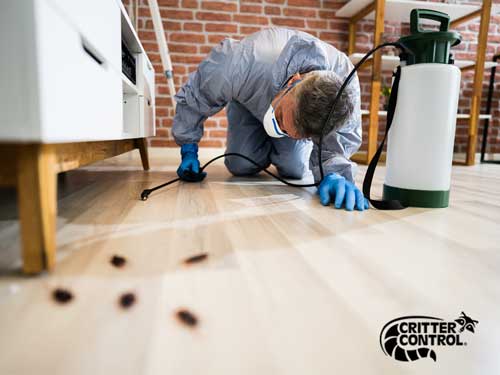Experienced A1 Exterminators Charlotte NC - Fast and Trusted Solutions
Experienced A1 Exterminators Charlotte NC - Fast and Trusted Solutions
Blog Article
Bed Insect Therapy Breakdown: Comparing Chemical Vs. Non-Chemical Solutions
In the world of insect control, especially when dealing with the persistent problem of bed pests, the choice between chemical and non-chemical treatment services can be a crucial one. Both methods provide unique advantages and disadvantages, affecting factors such as effectiveness, security considerations, and total cost. By taking a look at the nuanced information of each technique, a clearer understanding of which course to go after in resolving a bed pest problem can be acquired.
Efficiency of Chemical Treatments
Chemical treatments for bed pest invasions have actually been extensively recognized for their quick and potent efficiency in getting rid of these insects. When thinking about the effectiveness of chemical therapies, it is crucial to comprehend that they can provide a detailed and quick remedy to a bed insect issue.
In addition, chemical treatments have the advantage of using residual impacts, indicating that they can remain to remove bed pests also after the first application. This residual action is particularly beneficial in combating any type of potential re-infestations. Furthermore, the fast activity of chemical treatments can bring relief to people dealing with severe bed bug problems, allowing them to gain back control of their living areas swiftly.
Safety And Security Issues With Chemical Solutions
One critical element that requires mindful consideration when making use of chemical options for bed bug treatment is guaranteeing the safety and security of occupants and the atmosphere. Direct exposure to specific chemicals made use of in bed insect treatments can lead to respiratory system issues, skin inflammation, or various other adverse responses, particularly in people with pre-existing problems or sensitivities.
Additionally, the environmental effect of chemical remedies is another considerable consideration. Some pesticides used in bed pest therapies might be dangerous to advantageous bugs, wild animals, and environments if they leach right into the dirt or water systems. It is necessary to make use of chemical therapies sensibly, following security standards, and taking into consideration less poisonous alternatives to alleviate these dangers and guarantee the effective and safe management of bed insect problems.
Benefits of Non-Chemical Approaches
Thinking about the potential safety worries and ecological influence related to chemical options for bed pest therapy, checking out non-chemical strategies provides an encouraging choice with numerous distinctive advantages. Non-chemical methods offer a more secure alternative for houses, specifically those with youngsters, pet dogs, or people sensitive to severe chemicals. These methods eliminate the risks of exposure to toxic materials, minimizing the capacity for negative health and wellness effects. Additionally, non-chemical therapies are eco-friendly, as they do not add to air or water pollution, making them a lasting option for pest control.
In addition, non-chemical remedies can be effective in targeting bed insects, consisting of hard-to-reach locations where chemical therapies might not other permeate - A1 bed bug treatment in charlotte. Techniques such as warm therapy, vacuuming, heavy steam cleansing, and cushion coverings provide comprehensive obliteration without the use of hazardous chemicals.
Limitations of Non-Chemical Treatments

Furthermore, non-chemical treatments often call for several applications to attain effective obliteration. This can be taxing and may not always ensure full elimination of all bed pests and their eggs, particularly in surprise or hard-to-reach areas.
Moreover, the success of non-chemical therapies heavily relies on proper application and thoroughness, which can be challenging for individuals without specialist know-how. Poor application of non-chemical approaches might lead to insufficient obliteration, bring about relentless problems and the demand for additional treatments.
Therefore, while non-chemical treatments have their benefits, it is vital to acknowledge these restrictions and consider them when determining one of the most reliable strategy for taking care of bed bug problems.
Cost Contrast: Chemical Vs. Non-Chemical Options
Given the limitations linked with non-chemical treatments, a crucial element to evaluate in the context of bed pest management is the expense contrast between chemical and non-chemical choices. In comparison, non-chemical treatments like warmth treatment or steam can be this website much more expensive, with prices ranging from $1,000 to $6,000 for an entire home. While the first cost of chemical treatments may appear reduced, multiple treatments might be required to completely get rid of the infestation, possibly increasing the total expense.
Verdict

Taking into consideration the potential visit the site security worries and ecological impact linked with chemical services for bed pest treatment, exploring non-chemical strategies offers an appealing option with a number of distinct advantages.Provided the restrictions linked with non-chemical therapies, an important facet to review in the context of bed bug management is the cost comparison between chemical and non-chemical alternatives. In comparison, non-chemical treatments like warmth treatment or heavy steam can be much more costly, with prices varying from $1,000 to $6,000 for an entire home. While the preliminary cost of chemical therapies may seem lower, numerous therapies may be called for to totally eradicate the problem, potentially enhancing the overall cost.In conclusion, when comparing chemical and non-chemical bed pest treatment choices, it is essential to take into consideration performance, security, advantages, constraints, and expense.
Report this page